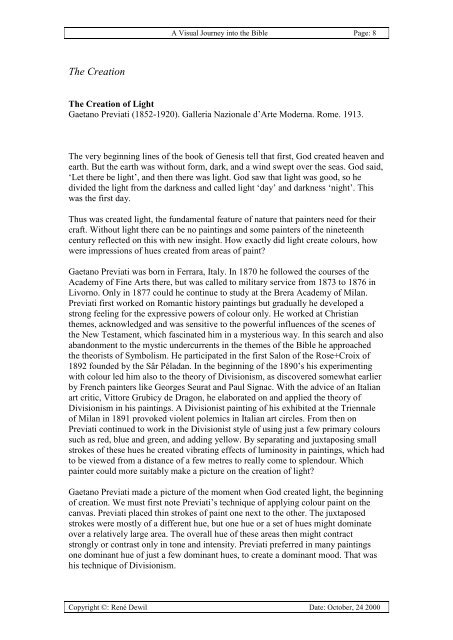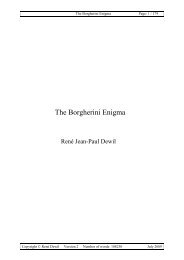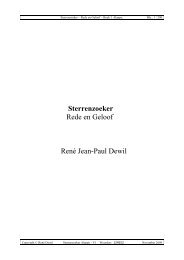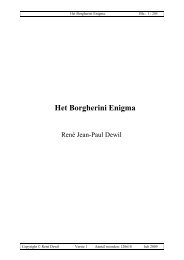A visual Journey into the Bible The Book of Genesis
A visual Journey into the Bible The Book of Genesis
A visual Journey into the Bible The Book of Genesis
You also want an ePaper? Increase the reach of your titles
YUMPU automatically turns print PDFs into web optimized ePapers that Google loves.
A Visual <strong>Journey</strong> <strong>into</strong> <strong>the</strong> <strong>Bible</strong> Page: 8<br />
<strong>The</strong> Creation<br />
<strong>The</strong> Creation <strong>of</strong> Light<br />
Gaetano Previati (1852-1920). Galleria Nazionale d’Arte Moderna. Rome. 1913.<br />
<strong>The</strong> very beginning lines <strong>of</strong> <strong>the</strong> book <strong>of</strong> <strong>Genesis</strong> tell that first, God created heaven and<br />
earth. But <strong>the</strong> earth was without form, dark, and a wind swept over <strong>the</strong> seas. God said,<br />
‘Let <strong>the</strong>re be light’, and <strong>the</strong>n <strong>the</strong>re was light. God saw that light was good, so he<br />
divided <strong>the</strong> light from <strong>the</strong> darkness and called light ‘day’ and darkness ‘night’. This<br />
was <strong>the</strong> first day.<br />
Thus was created light, <strong>the</strong> fundamental feature <strong>of</strong> nature that painters need for <strong>the</strong>ir<br />
craft. Without light <strong>the</strong>re can be no paintings and some painters <strong>of</strong> <strong>the</strong> nineteenth<br />
century reflected on this with new insight. How exactly did light create colours, how<br />
were impressions <strong>of</strong> hues created from areas <strong>of</strong> paint<br />
Gaetano Previati was born in Ferrara, Italy. In 1870 he followed <strong>the</strong> courses <strong>of</strong> <strong>the</strong><br />
Academy <strong>of</strong> Fine Arts <strong>the</strong>re, but was called to military service from 1873 to 1876 in<br />
Livorno. Only in 1877 could he continue to study at <strong>the</strong> Brera Academy <strong>of</strong> Milan.<br />
Previati first worked on Romantic history paintings but gradually he developed a<br />
strong feeling for <strong>the</strong> expressive powers <strong>of</strong> colour only. He worked at Christian<br />
<strong>the</strong>mes, acknowledged and was sensitive to <strong>the</strong> powerful influences <strong>of</strong> <strong>the</strong> scenes <strong>of</strong><br />
<strong>the</strong> New Testament, which fascinated him in a mysterious way. In this search and also<br />
abandonment to <strong>the</strong> mystic undercurrents in <strong>the</strong> <strong>the</strong>mes <strong>of</strong> <strong>the</strong> <strong>Bible</strong> he approached<br />
<strong>the</strong> <strong>the</strong>orists <strong>of</strong> Symbolism. He participated in <strong>the</strong> first Salon <strong>of</strong> <strong>the</strong> Rose+Croix <strong>of</strong><br />
1892 founded by <strong>the</strong> Sâr Péladan. In <strong>the</strong> beginning <strong>of</strong> <strong>the</strong> 1890’s his experimenting<br />
with colour led him also to <strong>the</strong> <strong>the</strong>ory <strong>of</strong> Divisionism, as discovered somewhat earlier<br />
by French painters like Georges Seurat and Paul Signac. With <strong>the</strong> advice <strong>of</strong> an Italian<br />
art critic, Vittore Grubicy de Dragon, he elaborated on and applied <strong>the</strong> <strong>the</strong>ory <strong>of</strong><br />
Divisionism in his paintings. A Divisionist painting <strong>of</strong> his exhibited at <strong>the</strong> Triennale<br />
<strong>of</strong> Milan in 1891 provoked violent polemics in Italian art circles. From <strong>the</strong>n on<br />
Previati continued to work in <strong>the</strong> Divisionist style <strong>of</strong> using just a few primary colours<br />
such as red, blue and green, and adding yellow. By separating and juxtaposing small<br />
strokes <strong>of</strong> <strong>the</strong>se hues he created vibrating effects <strong>of</strong> luminosity in paintings, which had<br />
to be viewed from a distance <strong>of</strong> a few metres to really come to splendour. Which<br />
painter could more suitably make a picture on <strong>the</strong> creation <strong>of</strong> light<br />
Gaetano Previati made a picture <strong>of</strong> <strong>the</strong> moment when God created light, <strong>the</strong> beginning<br />
<strong>of</strong> creation. We must first note Previati’s technique <strong>of</strong> applying colour paint on <strong>the</strong><br />
canvas. Previati placed thin strokes <strong>of</strong> paint one next to <strong>the</strong> o<strong>the</strong>r. <strong>The</strong> juxtaposed<br />
strokes were mostly <strong>of</strong> a different hue, but one hue or a set <strong>of</strong> hues might dominate<br />
over a relatively large area. <strong>The</strong> overall hue <strong>of</strong> <strong>the</strong>se areas <strong>the</strong>n might contract<br />
strongly or contrast only in tone and intensity. Previati preferred in many paintings<br />
one dominant hue <strong>of</strong> just a few dominant hues, to create a dominant mood. That was<br />
his technique <strong>of</strong> Divisionism.<br />
Copyright ©: René Dewil Date: October, 24 2000











